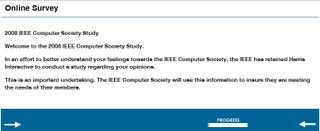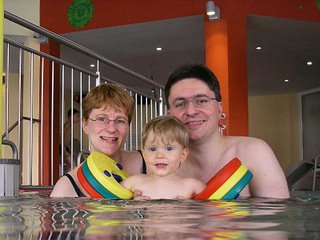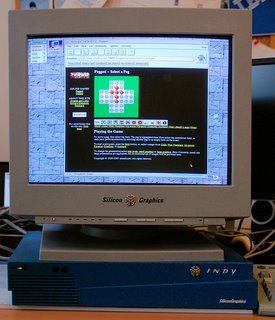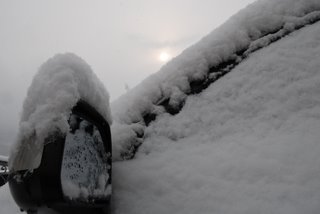Random thoughts
Saturday, April 19, 2008
Usability: When forward goes backward
The IEEE Computer Society recently invited members to participate in a survey. Admittedly, since taking on my current job I have developed a strange desire for taking surveys to see what others are doing and what we could learn from them.
Besides being too long (read: I stopped answering the survey once I figured this would take me longer than I was willing to click through question after question) this particular survey had an interesting usability problem: For some reason, the forward link to move to the next question is on the left, whereas the backward link is on the right:

The designer may have considered reading order or attempted to make the site more accessible by putting the more frequently used option first, which would be commendable, but the result is a poor navigation scheme. I would be curious to know how many respondents get frustrated about this and abandon the survey.
Besides being too long (read: I stopped answering the survey once I figured this would take me longer than I was willing to click through question after question) this particular survey had an interesting usability problem: For some reason, the forward link to move to the next question is on the left, whereas the backward link is on the right:

The designer may have considered reading order or attempted to make the site more accessible by putting the more frequently used option first, which would be commendable, but the result is a poor navigation scheme. I would be curious to know how many respondents get frustrated about this and abandon the survey.
Labels: usability
Friday, April 18, 2008
VPS, PDC, DVB, EPG—Why can VCRs not just work?
Video cassette recorders (VCR) have a long-standing reputation for being difficult to use (searching for VCR and usability returns some 90,000 results on Google).
In the early days setting the timer right may have been challenging, and too often the program would change or fall behind and the tape would contain a different program, or a cut off film. Then came the Video Programming System (VPS) and ShowView, which made programming VCRs easy and greatly increased the likelihood of recording the desired program, and later Programme Delivery Control (PDC).
Everything seemed fine until last year when a decision was made to discontinue analog TV broadcasting in Austria and switching to Digial Video Broadcasting (DVB-T). The television system had maintained backwards compatibility with the great many enhancements over the years, from black-and-white to color, from mono to stereo and dual channel audio. This time, however, new equipment would be needed in the form of DVB-T receivers, and of course that means one for each TV set and recorder.
Our first attempt with a twin receiver bought on EBay was a dismal failure. The device seemed malfunctioning and vendor support was non-existent (more precisely, we were unable to locate the vendor, which seemed to have gone out of business). We happily lived for a few weeks without television.
Eventually we got a nice Sony HXD-870 HD/DVD recorder with built-in DVB-T tuner and at first were quite happy. Setting up the device was easy (except for the fact it did not recognize Austria as a country) and we were back to receiving and recording TV programs.
Although the new recorder supports VPS/PDC it does so only from analog sources, which are no longer available, but not from the digital signal despite the fact that the VPS signal is sent digitally as well. The new Electronic Program Guide (EPG) is convenient, but there is no way to tell the recorder to start when the program starts. Instead you can manually tweak the time range to increase the likelihood of recording the full program.
If that wasn't bad enough already, when we switched to daylight savings time, or summer time as it's called here, the program guide appeared to be off by one hour and so were all recordings. There is a timezone menu but toggling daylight savings time on and off did not seem to make any difference.
The Sony support Website was less than helpful. The only firmware upgrade was for the UK version of the recorder and fixed an unrelated problem that we hadn't encountered.
Fortunately a kind soul owning the same device came to rescue and shared instructions how to overcome this bug by switching to a different time zone and then rebooting the recorder. We have since been running on Helsinki time and had mixed success in recording programs.
With all the advances in technology and three-letter acronym features, we are essentially back to the functionality in the early days of video recording, manually setting times and hoping for the program to stay on schedule.
Why can VCRs not just work?
In the early days setting the timer right may have been challenging, and too often the program would change or fall behind and the tape would contain a different program, or a cut off film. Then came the Video Programming System (VPS) and ShowView, which made programming VCRs easy and greatly increased the likelihood of recording the desired program, and later Programme Delivery Control (PDC).
Everything seemed fine until last year when a decision was made to discontinue analog TV broadcasting in Austria and switching to Digial Video Broadcasting (DVB-T). The television system had maintained backwards compatibility with the great many enhancements over the years, from black-and-white to color, from mono to stereo and dual channel audio. This time, however, new equipment would be needed in the form of DVB-T receivers, and of course that means one for each TV set and recorder.
Our first attempt with a twin receiver bought on EBay was a dismal failure. The device seemed malfunctioning and vendor support was non-existent (more precisely, we were unable to locate the vendor, which seemed to have gone out of business). We happily lived for a few weeks without television.
Eventually we got a nice Sony HXD-870 HD/DVD recorder with built-in DVB-T tuner and at first were quite happy. Setting up the device was easy (except for the fact it did not recognize Austria as a country) and we were back to receiving and recording TV programs.
Although the new recorder supports VPS/PDC it does so only from analog sources, which are no longer available, but not from the digital signal despite the fact that the VPS signal is sent digitally as well. The new Electronic Program Guide (EPG) is convenient, but there is no way to tell the recorder to start when the program starts. Instead you can manually tweak the time range to increase the likelihood of recording the full program.
If that wasn't bad enough already, when we switched to daylight savings time, or summer time as it's called here, the program guide appeared to be off by one hour and so were all recordings. There is a timezone menu but toggling daylight savings time on and off did not seem to make any difference.
The Sony support Website was less than helpful. The only firmware upgrade was for the UK version of the recorder and fixed an unrelated problem that we hadn't encountered.
Fortunately a kind soul owning the same device came to rescue and shared instructions how to overcome this bug by switching to a different time zone and then rebooting the recorder. We have since been running on Helsinki time and had mixed success in recording programs.
With all the advances in technology and three-letter acronym features, we are essentially back to the functionality in the early days of video recording, manually setting times and hoping for the program to stay on schedule.
Why can VCRs not just work?
Labels: technology, usability
Tuesday, April 15, 2008
Back from vacation
We just returned from a few relaxing days at Reiter's Burgenlandresort in Bad Tatzmannsdorf.

This is the second time we stayed at this hotel, and we had a great time again. Elias enjoyed the many opportunities for playing, sliding and swimming, and the hotel even offered introductory Tai Chi lessons (as I found out afterwards, a different Tai Chi style from the one we learn, which would explain why moves by the same names would feel different).

This is the second time we stayed at this hotel, and we had a great time again. Elias enjoyed the many opportunities for playing, sliding and swimming, and the hotel even offered introductory Tai Chi lessons (as I found out afterwards, a different Tai Chi style from the one we learn, which would explain why moves by the same names would feel different).
Labels: personal
Monday, March 24, 2008
Goodbye, Indy!
Time has come to say Goodbye to my Silicon Graphics Indy workstation. It has been a difficult relationship for years, and I finally offered my Indy on EBay.

Introduced in 1993, the Indy for a long time was the workstation to have, powerful and good looking, too. When EuNet, PING and Computerwelt offered a fully equipped Indy workstation as the reward for the best Austrian Website, my good friend Peter Wansch and I submitted The WWW Entertainment Package, a collection of classic board games ported to the Web from the like-named OS/2 games package that Peter had developed.
I had just learned the basics of writing CGI scripts and managed to get four games up and running. Although playing games over the Web was kind of slow in the pre-JavaScript, pre-AJAX era the gaming site was very well received and generated both lots of traffic and nice feedback from gamers around the world, too. We asked people to register for free access, we made it easy for them to vote and we spent a considerable amount of time answering e-mails and encouraging games to vote.
To make a long story short, we won. In hindsight, we had a pretty good Website that was actively used and would continue for years, but some other submissions were pretty slick, too. I guess we didn't just win for having the best product, we won because of good marketing.
The news reached me while participating at the WWW3 Conference in Darmstadt and while I had been hoping for this when it happened I could hardly believe it—we did it!
What followed then was a huge disappointment. We learned that we would not receive the machine at the official ceremony at Café Stein but only a few weeks later, and what's worse in a different configuration: The 5 GB harddisk that was originally advertised may seem small today but would have been perfectly adequate back then, what we got instead was a machine with a much smaller harddisk, barely sufficient to hold the base operating system and multimedia tools, and no CD-ROM drive to install software from.
Now the Indy came with great connectivity already, including Ethernet and ISDN ports, only my home office had neither and upgrading the machine with more memory, a larger harddisk and a CD-ROM drive (from Silicon Graphics only, others would not boot!) was too expensive an option. We could have sold the Indy, probably for a good price. Seriously though, if you got an Indy, would you sell it? (Don't answer, please.)
So for many years this marvel of technology has been putting on dust and remained unused. When I booted the Indy today it started up nicely, only issuing one warning message: “WARNING: clock gained 1856 days”
The auction has a few more days to go and already has six bids. It is about time that someone starts using this machine, and time for me to say Goodbye. It has been a difficult relationship, and yet I will miss this electric-blue colored pizza box.
PS. At the age of fifteen the Indy is still a modern computer. For some really old computers, have a look at the Old Computers online museum.

Introduced in 1993, the Indy for a long time was the workstation to have, powerful and good looking, too. When EuNet, PING and Computerwelt offered a fully equipped Indy workstation as the reward for the best Austrian Website, my good friend Peter Wansch and I submitted The WWW Entertainment Package, a collection of classic board games ported to the Web from the like-named OS/2 games package that Peter had developed.
I had just learned the basics of writing CGI scripts and managed to get four games up and running. Although playing games over the Web was kind of slow in the pre-JavaScript, pre-AJAX era the gaming site was very well received and generated both lots of traffic and nice feedback from gamers around the world, too. We asked people to register for free access, we made it easy for them to vote and we spent a considerable amount of time answering e-mails and encouraging games to vote.
To make a long story short, we won. In hindsight, we had a pretty good Website that was actively used and would continue for years, but some other submissions were pretty slick, too. I guess we didn't just win for having the best product, we won because of good marketing.
The news reached me while participating at the WWW3 Conference in Darmstadt and while I had been hoping for this when it happened I could hardly believe it—we did it!
What followed then was a huge disappointment. We learned that we would not receive the machine at the official ceremony at Café Stein but only a few weeks later, and what's worse in a different configuration: The 5 GB harddisk that was originally advertised may seem small today but would have been perfectly adequate back then, what we got instead was a machine with a much smaller harddisk, barely sufficient to hold the base operating system and multimedia tools, and no CD-ROM drive to install software from.
Filesystem Type kbytes use avail %use Mounted on
/dev/root efs 439704 408189 31515 93% /
Now the Indy came with great connectivity already, including Ethernet and ISDN ports, only my home office had neither and upgrading the machine with more memory, a larger harddisk and a CD-ROM drive (from Silicon Graphics only, others would not boot!) was too expensive an option. We could have sold the Indy, probably for a good price. Seriously though, if you got an Indy, would you sell it? (Don't answer, please.)
So for many years this marvel of technology has been putting on dust and remained unused. When I booted the Indy today it started up nicely, only issuing one warning message: “WARNING: clock gained 1856 days”
The auction has a few more days to go and already has six bids. It is about time that someone starts using this machine, and time for me to say Goodbye. It has been a difficult relationship, and yet I will miss this electric-blue colored pizza box.
PS. At the age of fifteen the Indy is still a modern computer. For some really old computers, have a look at the Old Computers online museum.
Labels: personal, technology
Let it snow, let it snow, let is snow

Happy Easter, or whatever you celebrated over the last few days. As reported by Time Magazine Good Friday this year happened to coincide with many holidays of other religions: Purim, Narouz, Eid Milad an Nabi, Small Holi and Magha Puja.
We spent the Holy Week in Salzburg with Andrea's parents and had hoped for some nice warm spring days to go for walks or just hang around on the terrace—not so. With a forecast for cold weather and even snow over the weekend, we saw the traditional Sunday Easter egg hunt at risk and decided to cheat just a little, letting the Easter bunny hide his eggs on Saturday already. Elias was quite happy about this and managed to quickly spot and collect all baskets with eggs, chocolates and yet another picture book.



Moving the egg hunt turned out to be a smart choice. Sunday started out pretty nice as we went to church but then it would snow heavily for hours. Despite the car rental agency giving us an upgrade to a 4 wheel drive we even extended our stay at my in-law's place by another night and only headed back to Vienna today.
Now see what our car looked like in the morning! We had a pleasant drive though, with surprisingly light traffic on the highway.

Labels: personal
Tuesday, February 26, 2008
Safely landed
I am in Germany this week for training on e-procurement and business process modeling.
Three colleagues from Bratislava and I made it to the IBM facility in Herrenberg, which wouldn't be noteworthy except that the newspapers had detailed reports about an emergency landing of a Dash 8-Q400 at Vienna airport yesterday, and sure enough our plane was a Dash 8-Q400 too. The board magazine highlighted the benefits of the aircraft, such as lower fuel consumption than jets at relatively high speeds, the ability to take off and land on short runways, propellers which can be repositioned for excellent climb and cruise performance, and noise and vibration reduction for the cabin.
I didn't feel particularly unsafe even after reading the morning news as the many problems reported with this type of aircraft have been mostly related to the landing gear and there haven't been any serious accidents. Sure enough our flight went smoothly and we safely landed in Stuttgart.
Three colleagues from Bratislava and I made it to the IBM facility in Herrenberg, which wouldn't be noteworthy except that the newspapers had detailed reports about an emergency landing of a Dash 8-Q400 at Vienna airport yesterday, and sure enough our plane was a Dash 8-Q400 too. The board magazine highlighted the benefits of the aircraft, such as lower fuel consumption than jets at relatively high speeds, the ability to take off and land on short runways, propellers which can be repositioned for excellent climb and cruise performance, and noise and vibration reduction for the cabin.
I didn't feel particularly unsafe even after reading the morning news as the many problems reported with this type of aircraft have been mostly related to the landing gear and there haven't been any serious accidents. Sure enough our flight went smoothly and we safely landed in Stuttgart.
Labels: travel
Monday, January 21, 2008
No wonder that this world blows itself up
While standing in line at the supermarket today, I overheard a lively discussion between the cashier and a customer who complained about not getting the discount price advertised on the rack.
This supermarket chain runs a fairly elaborate customer loyalty program, with some discounts applying only to members of the program. There used to be some problems in the past with keeping the signs and the computer systems in sync but not this time. There was no technical problem here, just an oversight on the customer's part.
The customer eventually agreed that the discount wasn't applicable, since she was not and did not want to join the customer loyalty program, and decided to return the tomatoes, mumbling something along the lines of "Everything is getting so much more complicated, no wonder that this world blows itself up."
Now I wouldn't consider the customer loyalty program a serious threat to the world, and actually enjoy the benefits offered, although it means knowingly giving up some privacy in exchange for discounts. (I will gladly post my grocery shopping list here too if someone is interested :-))
Scanner cash registers and storing membership information electronically on the ATM card are certainly vast improvements in usability and convenience over the old manual cash registers (I do remember checking my weekly grocery bill for errors back when I was a student, a rather slow process given the long list of just prices, but it was worth the effort more than once) and collecting discount coupons.
Those of us working in a technology industry should remember though that not everyone will want to or have the ability to adopt new technologies, and those who opt out must not be left behind.
Otherwise, this world will blow itself up ...
This supermarket chain runs a fairly elaborate customer loyalty program, with some discounts applying only to members of the program. There used to be some problems in the past with keeping the signs and the computer systems in sync but not this time. There was no technical problem here, just an oversight on the customer's part.
The customer eventually agreed that the discount wasn't applicable, since she was not and did not want to join the customer loyalty program, and decided to return the tomatoes, mumbling something along the lines of "Everything is getting so much more complicated, no wonder that this world blows itself up."
Now I wouldn't consider the customer loyalty program a serious threat to the world, and actually enjoy the benefits offered, although it means knowingly giving up some privacy in exchange for discounts. (I will gladly post my grocery shopping list here too if someone is interested :-))
Scanner cash registers and storing membership information electronically on the ATM card are certainly vast improvements in usability and convenience over the old manual cash registers (I do remember checking my weekly grocery bill for errors back when I was a student, a rather slow process given the long list of just prices, but it was worth the effort more than once) and collecting discount coupons.
Those of us working in a technology industry should remember though that not everyone will want to or have the ability to adopt new technologies, and those who opt out must not be left behind.
Otherwise, this world will blow itself up ...
Labels: technology, usability
Saturday, January 19, 2008
Learning Tai Chi
The well-being team at IBM offers a variety of courses to keep everyone fit and health.
Yesterday morning (at 8 a.m., I am not exactly a morning person so this was the hard part) I had my first Tai Chi lesson. Our teacher, Chung Hsien Jung, has won national and international Tai Chi championships, and more importantly creates a friendly and inviting atmosphere. Watching him perform a sequence of postures and moves is simply impressive and a good motivation to spend an hour or two every week to practice Tai Chi myself (not that I expect to get anywhere close to this level, but that's beside the point).
Tai Chi is based on the theory of the Taoism and the principle of the contrasts of Yin and Yang. The sequences of moves are used for supporting healthiness, relaxation and physical balance. We learn the Chen Style (陳氏), the oldest form of Tai Chi characterized by the combination of slow, supple and fast, powerful movements. To some extent the concepts and the moves reminded me of Jujitsu, which I had practiced many years ago.
The first lesson was fun, so I will be back again next week!
Yesterday morning (at 8 a.m., I am not exactly a morning person so this was the hard part) I had my first Tai Chi lesson. Our teacher, Chung Hsien Jung, has won national and international Tai Chi championships, and more importantly creates a friendly and inviting atmosphere. Watching him perform a sequence of postures and moves is simply impressive and a good motivation to spend an hour or two every week to practice Tai Chi myself (not that I expect to get anywhere close to this level, but that's beside the point).
Tai Chi is based on the theory of the Taoism and the principle of the contrasts of Yin and Yang. The sequences of moves are used for supporting healthiness, relaxation and physical balance. We learn the Chen Style (陳氏), the oldest form of Tai Chi characterized by the combination of slow, supple and fast, powerful movements. To some extent the concepts and the moves reminded me of Jujitsu, which I had practiced many years ago.
The first lesson was fun, so I will be back again next week!
Labels: personal
localhost considered harmful
Tavis Ormandy has posted a potential security exposure with DNS entries for "localhost" in zone files on Bugtraq. While the impact of this exposure seems minimal, I would rather err on the side of caution, and this should be fairly easy to fix.
"localhost" DNS records in a domain should not be confused with the ".localhost" TLD defined in RFC 2606 Reserved Top Level DNS Names, and should be configured on nameservers. I haven't been able to find a requirement in the RFCs to have a "localhost" entry in a domain, nor can I think of a compelling reason for keeping the entry as long as nameservers for a domain are properly configured to handle queries for "localhost.".
RFC 1912 Common DNS Errors explains how to configure the localhost and 0.0.127.in-addr.arpa zones:
and recommends to not define "localhost" with the domain name appended.
Thoughts on removing "localhost" from zones, anyone?
"localhost" DNS records in a domain should not be confused with the ".localhost" TLD defined in RFC 2606 Reserved Top Level DNS Names, and should be configured on nameservers. I haven't been able to find a requirement in the RFCs to have a "localhost" entry in a domain, nor can I think of a compelling reason for keeping the entry as long as nameservers for a domain are properly configured to handle queries for "localhost.".
RFC 1912 Common DNS Errors explains how to configure the localhost and 0.0.127.in-addr.arpa zones:
The "localhost" address is a "special" address which always refers to
the local host. It should contain the following line:
localhost. IN A 127.0.0.1
The "127.0" file should contain the line:
1 PTR localhost.
and recommends to not define "localhost" with the domain name appended.
Thoughts on removing "localhost" from zones, anyone?
Labels: security, technology
Monday, January 14, 2008
Blogger
Choosing a hosted service for blogging was a matter of a few minutes, and it didn't involve working through feature lists and comparison charts.
I started playing with Blogger and within minutes had a basic template and publishing to my Web server working. The template language looked sufficiently flexible, and the backing by search giant Google made this an attractive choice too.
WordPress would have been next on my review list. The hosted options are probably comparable, with WordPress offering some advanced features for a fee. Anita Campbell has published a great article about moving a blog from Blogger to WordPress, citing a number of good reasons why the latter is a much better option, although Blogger was “simple to set up and use”. Good enough for me.
One minor limitation I noticed is that Blogger only creates a single XML feed but no category feeds, which can be created easily using the rich Blogger data API.
The only complaint I have about Blogger is the incorrect rendering of ampersand and angle quotes:
They are represented correctly as entities in the XML feed, but rendered as plain characters in the HTML version. This looks like a bug that should be easy enough to fix.
I started playing with Blogger and within minutes had a basic template and publishing to my Web server working. The template language looked sufficiently flexible, and the backing by search giant Google made this an attractive choice too.
WordPress would have been next on my review list. The hosted options are probably comparable, with WordPress offering some advanced features for a fee. Anita Campbell has published a great article about moving a blog from Blogger to WordPress, citing a number of good reasons why the latter is a much better option, although Blogger was “simple to set up and use”. Good enough for me.
One minor limitation I noticed is that Blogger only creates a single XML feed but no category feeds, which can be created easily using the rich Blogger data API.
The only complaint I have about Blogger is the incorrect rendering of ampersand and angle quotes:
- Ampersand: &
- Angle bracket open: <
- Angle bracket close: >
They are represented correctly as entities in the XML feed, but rendered as plain characters in the HTML version. This looks like a bug that should be easy enough to fix.
Labels: google, technology
Sunday, January 13, 2008
IG-L
When we spent our summer vacation in Sicily in 2004, I often wondered why some road signs in Sicily listed detailed information about the relevant laws and even the specific section and paragraph of the act.
Since 2006, the immission control act Immissionsschutzgesetz-Luft (IG-L) has been enacted in Austria, which allows authorities to impose certain restrictions on production facilities, traffic, and outdoor combustion to reduce immissions when pollution thresholds are exceeded.
The act requires that immission control related speed limit must be signposted with reference to the act. On previous trips between Vienna and Salzburg I had complained about the unnecessary distraction by additional signs; after all I don't usually care why a speed limit has been put in place, although there is evidence that drivers are more likely to adhere to environmentally motivated speed limits (source: Luftreinhalteplan Stuttgart), and lower speeds generally mean lower emissions (source: Land Tirol: Tempo 100).
One set of road signs around Linz looks especially bizarre: a combination of lifting the 100 km/h speed limit and introducing a 100 km/h speed limit for immission control, and vice versa in the opposite direction.
Recently some of the roadsigns were replaced with large over-the-road displays which allow for dynamic speed limits depending on weather conditions, traffic flow and pollution levels, which is goodness. I wonder though how many drivers will have a clue what the big white letters IG-L next to the speed limit signs mean ...
Since 2006, the immission control act Immissionsschutzgesetz-Luft (IG-L) has been enacted in Austria, which allows authorities to impose certain restrictions on production facilities, traffic, and outdoor combustion to reduce immissions when pollution thresholds are exceeded.
The act requires that immission control related speed limit must be signposted with reference to the act. On previous trips between Vienna and Salzburg I had complained about the unnecessary distraction by additional signs; after all I don't usually care why a speed limit has been put in place, although there is evidence that drivers are more likely to adhere to environmentally motivated speed limits (source: Luftreinhalteplan Stuttgart), and lower speeds generally mean lower emissions (source: Land Tirol: Tempo 100).
One set of road signs around Linz looks especially bizarre: a combination of lifting the 100 km/h speed limit and introducing a 100 km/h speed limit for immission control, and vice versa in the opposite direction.
Recently some of the roadsigns were replaced with large over-the-road displays which allow for dynamic speed limits depending on weather conditions, traffic flow and pollution levels, which is goodness. I wonder though how many drivers will have a clue what the big white letters IG-L next to the speed limit signs mean ...
Labels: technology, travel
Tuesday, January 1, 2008
Happy New Year 2008
We wish you all a happy, healthy and prosperous new year 2008!

We spent new year's eve with Andrea's parents and friends in Salzburg. The weather was foggy so the fireworks weren't that impressive this year, and we did forgo the midnight waltz on the icy terrace as well.

Today was another lazy day, we listened to the New Year's Concert 2008 under Georges Prêtre while we had breakfast, and Elias became inspired to dance to the music after seeing ballet dancers on TV, which was very, very cute.
We did go for a walk around Aigen in the afternoon and Elias had a chance to see real cows in a stable nearby, he looked quite impressed. This was our last vacation day in Salzburg; tomorrow afternoon we will return to Vienna.

We spent new year's eve with Andrea's parents and friends in Salzburg. The weather was foggy so the fireworks weren't that impressive this year, and we did forgo the midnight waltz on the icy terrace as well.

Today was another lazy day, we listened to the New Year's Concert 2008 under Georges Prêtre while we had breakfast, and Elias became inspired to dance to the music after seeing ballet dancers on TV, which was very, very cute.
We did go for a walk around Aigen in the afternoon and Elias had a chance to see real cows in a stable nearby, he looked quite impressed. This was our last vacation day in Salzburg; tomorrow afternoon we will return to Vienna.
Labels: personal
Monday, December 24, 2007
Season's Greetings

Wishing everyone Merry Christmas, Frohe Weihnachten, Joyeux Noël, Feliz Navidad, Bon Nadal, Glædelig Jul, Prettig Kerstfeest, Hyvaa joulua, Gledelig Jul, Sretan Bozic, Buone Feste Natalizie and wonderful holidays!
Labels: personal
Wednesday, December 19, 2007
I, Blogger
So I have finally started my blog. While the blogosphere continues to grow at an amazing speed, some bloggers of the early days have already switched back to a static homepage they update every now and then, or gone completely offline.
Why now? No particular reason really. I have been playing with the idea of creating a blog and have written up a few blog posts locally without publishing them, just to see how I liked it and what I would have to say. (A few of those early secret blog posts still sit on my hard disk and will eventually show up here retroactively.)
Looking back, I first maintained plogs (for “paper logs”) some 20 years ago when Andrea and I were traveling around in Europe by train. Each of us would write down the experiences of the day, where we went, what we liked and disliked, just about anything that came to mind, in a small booklet. When we were both done with writing, we would read each other's notes, which was great fun.
The intended readership of these plogs was one person. The esteemed readership of this blog may be about the same size currently. By coincidence, Bernhard just started blogging too, so that makes us two late adopters and ensures each of us has at least one reader. Onward.
Next, there was a technology decision to be made: install blogging software or use a hosted service. Ed Costello had shared his experience with getting Movable Type working on pair Networks servers, reading through the steps and given that I wasn't planning to spend more than an hour or two in getting things running I chose to go with a hosted service, Blogger, and have been pretty pleased with it.
Why now? No particular reason really. I have been playing with the idea of creating a blog and have written up a few blog posts locally without publishing them, just to see how I liked it and what I would have to say. (A few of those early secret blog posts still sit on my hard disk and will eventually show up here retroactively.)
Looking back, I first maintained plogs (for “paper logs”) some 20 years ago when Andrea and I were traveling around in Europe by train. Each of us would write down the experiences of the day, where we went, what we liked and disliked, just about anything that came to mind, in a small booklet. When we were both done with writing, we would read each other's notes, which was great fun.
The intended readership of these plogs was one person. The esteemed readership of this blog may be about the same size currently. By coincidence, Bernhard just started blogging too, so that makes us two late adopters and ensures each of us has at least one reader. Onward.
Next, there was a technology decision to be made: install blogging software or use a hosted service. Ed Costello had shared his experience with getting Movable Type working on pair Networks servers, reading through the steps and given that I wasn't planning to spend more than an hour or two in getting things running I chose to go with a hosted service, Blogger, and have been pretty pleased with it.
Labels: personal, technology
Thursday, December 13, 2007
jQuery and Greasemonkey
Now that Fiddler stopped working for me I used Greasemonkey to modify pages on the fly to test some new functionality.
It took me a while to figure out why a global variable which one of the dynamically added scripts created was not visible to my Greasemonkey script. Of course the answer was right there in the Greasemonkey documentation: "As of Greasemonkey 0.6.4, however, user scripts now have their own JavaScript context and execute completely separately from the content document." Fortunately, the document window is also accessible as unsafeWindow, and sure enough that worked.
PS. Michael Baierl pointed out a sample Greasemonkey script to load jQuery before executing functions that depend on jQuery—nice!
It took me a while to figure out why a global variable which one of the dynamically added scripts created was not visible to my Greasemonkey script. Of course the answer was right there in the Greasemonkey documentation: "As of Greasemonkey 0.6.4, however, user scripts now have their own JavaScript context and execute completely separately from the content document." Fortunately, the document window is also accessible as unsafeWindow, and sure enough that worked.
PS. Michael Baierl pointed out a sample Greasemonkey script to load jQuery before executing functions that depend on jQuery—nice!
Labels: javascript, webdevelopment
Sunday, December 9, 2007
Taking Sunday off
Andrea and I took Sunday off this week. Elias stayed with his grandparents at my sister-in-law's place, the first time ever without one of us around at night, and it worked out nicely.
We missed him on the way home already, but waking up at 10:30 a.m. without the usual "Mama, Papa, Frühstück, aussa, rasch" was very enjoyable for a change. The weather wasn't great so we stayed home and spent the day messing around.
Elias had a good time and didn't seem to miss us too much.
We missed him on the way home already, but waking up at 10:30 a.m. without the usual "Mama, Papa, Frühstück, aussa, rasch" was very enjoyable for a change. The weather wasn't great so we stayed home and spent the day messing around.
Elias had a good time and didn't seem to miss us too much.
Labels: personal
Friday, December 7, 2007
The 4-Hour Workweek
An interview "The Business of Life" first triggered my interest in The 4-Hour Workweek: Escape 9-5, Live Anywhere, and Join the New Rich by Timothy Ferris.
Of course even the author will readily admit that one should "not to take the four hours too literally" and it certainly makes a catchier title than "Save an hour per week for things you like", but then anything that means getting more done with less effort and having more time left for the things you really enjoy is good, right?
Ferris may get some basic facts wrong, as readers noted on amazon.com, but he certainly gets his marketing right. His book must have been featured in about every TV show and newspaper by now, judging from the number of comments and the news coverage since. Some claim this book changed their lives while others feel tricked by the simple, well-known recipes -- not everyone is going to make a living from selling nutritional supplements.
Despite the criticism I ordered my copy last month (so I guess the concept worked!) and also added Getting Things Done: The Art of Stress-Free Productivity, which received favorable comments that I can relate to.
The books were in the mail today, and I will start reading them over the holidays. They probably won't significantly change my life but they should make light reading over the holidays and nicely complement the fiction books, and they may even give me some useful ideas for New Year's resolutions.
Of course even the author will readily admit that one should "not to take the four hours too literally" and it certainly makes a catchier title than "Save an hour per week for things you like", but then anything that means getting more done with less effort and having more time left for the things you really enjoy is good, right?
Ferris may get some basic facts wrong, as readers noted on amazon.com, but he certainly gets his marketing right. His book must have been featured in about every TV show and newspaper by now, judging from the number of comments and the news coverage since. Some claim this book changed their lives while others feel tricked by the simple, well-known recipes -- not everyone is going to make a living from selling nutritional supplements.
Despite the criticism I ordered my copy last month (so I guess the concept worked!) and also added Getting Things Done: The Art of Stress-Free Productivity, which received favorable comments that I can relate to.
The books were in the mail today, and I will start reading them over the holidays. They probably won't significantly change my life but they should make light reading over the holidays and nicely complement the fiction books, and they may even give me some useful ideas for New Year's resolutions.
Saturday, December 1, 2007
Spam filtering with countries.nerd.dk considered harmful
DNS blacklists (DNSBL) provide information about characteristics and past observations of IP addresses and have been used in filtering spam for more than a decade. In short, a spam filter may check one or more DNSBL services to determine if the network address from where an e-mail is delivered is trustworthy or suspicious.
Besides listing addresses of known spam sources or virus-infected machines, there are lists for criteria such as network type (dial-up/cable/DSL) and configuration issues (open relays, RFC non-compliance).
One of my colleagues recently had e-mail to a client rejected by their mail gateway with the error message "554 Your Host 32.nn.nn.nn was found in the DNS BlackList at uk.countries.nerd.dk."
When he asked for help with this, my first thought was that one of our addresses had, rightly or wrongly, been listed as a spam source. However, after looking around countries.nerd.dk it became clear that the recipient was blocking all mail that appeared to come from certain countries according to the countries.nerd.dk database despite the disclaimer on that Website that "countries.nerd.dk is NOT a list of spammers, it is an IP-to-country DNS mapping service."
What's worse in this case is that the mapping was incorrect: The whole 32/8 netblock is declared to be based in the UK: "32.0.0.0/8 :127.0.0.2:Your IP is in uk, rejected based on geographical location". There may be some UK based addresses in that netblock but others are located in North America and possible other places too, and similar geographic mapping services managed to get the location of the particular mail server (almost) right.
Although many open source and commercial mail filters rely on DNSBLs, there has been valid criticism, and even lawsuits against DNSBL operators. The main concern I have is that administrators may rely on a single DNSBL service to mark messages as spam and reject them without understanding the service's reliability and limitations.
Besides listing addresses of known spam sources or virus-infected machines, there are lists for criteria such as network type (dial-up/cable/DSL) and configuration issues (open relays, RFC non-compliance).
One of my colleagues recently had e-mail to a client rejected by their mail gateway with the error message "554 Your Host 32.nn.nn.nn was found in the DNS BlackList at uk.countries.nerd.dk."
When he asked for help with this, my first thought was that one of our addresses had, rightly or wrongly, been listed as a spam source. However, after looking around countries.nerd.dk it became clear that the recipient was blocking all mail that appeared to come from certain countries according to the countries.nerd.dk database despite the disclaimer on that Website that "countries.nerd.dk is NOT a list of spammers, it is an IP-to-country DNS mapping service."
What's worse in this case is that the mapping was incorrect: The whole 32/8 netblock is declared to be based in the UK: "32.0.0.0/8 :127.0.0.2:Your IP is in uk, rejected based on geographical location". There may be some UK based addresses in that netblock but others are located in North America and possible other places too, and similar geographic mapping services managed to get the location of the particular mail server (almost) right.
Although many open source and commercial mail filters rely on DNSBLs, there has been valid criticism, and even lawsuits against DNSBL operators. The main concern I have is that administrators may rely on a single DNSBL service to mark messages as spam and reject them without understanding the service's reliability and limitations.
Labels: spam, technology
Wednesday, November 28, 2007
Phone line working again
Last Wednesday, my home office phone line all of a sudden stopped working. The telecom provider tried to reset devices along the route to my home to no avail, so they promised that someone would look into the problem and call me back within 48 hours (on my other line, of course).
Time went by, and at Friday night nobody had called, and my phone line still was not working, so I called again. After enjoying some 20 minutes of "All service representatives are currently serving other ..." I spoke to someone who admitted that nothing had been done about my problem, and nothing could be done about my problem as it was now out of hours and technical staff would be back on Monday morning, I would get a call.
You probably guessed the response when I called again Monday morning, the problem ticket was still untouched and we scheduled an appointment for an on-site check this morning. My phone line was still dead and my mood had shifted from annoyed to resigned already. Around 2 a.m. in the morning, just about before going to sleep, for some reason I tried one more time and—my phone line was perfectly fine again! (This is like me feeling much better already when I have an appointment scheduled with a doctor, all the symptoms just go away and I question the need to see the doctor. Electronic devices seem to work the same way.)
The one week phone outage had a positive side effect though: Desperately trying to regain the convenience of a desk phone with a headset and a mute button, I successfully connected my mobile phone to my desk phone via Bluetooth. To my great surprise, this works perfectly fine. I can easily accept mobile calls on my desk phone, and choose between land line and mobile phone for outgoing calls ... nice!
Time went by, and at Friday night nobody had called, and my phone line still was not working, so I called again. After enjoying some 20 minutes of "All service representatives are currently serving other ..." I spoke to someone who admitted that nothing had been done about my problem, and nothing could be done about my problem as it was now out of hours and technical staff would be back on Monday morning, I would get a call.
You probably guessed the response when I called again Monday morning, the problem ticket was still untouched and we scheduled an appointment for an on-site check this morning. My phone line was still dead and my mood had shifted from annoyed to resigned already. Around 2 a.m. in the morning, just about before going to sleep, for some reason I tried one more time and—my phone line was perfectly fine again! (This is like me feeling much better already when I have an appointment scheduled with a doctor, all the symptoms just go away and I question the need to see the doctor. Electronic devices seem to work the same way.)
The one week phone outage had a positive side effect though: Desperately trying to regain the convenience of a desk phone with a headset and a mute button, I successfully connected my mobile phone to my desk phone via Bluetooth. To my great surprise, this works perfectly fine. I can easily accept mobile calls on my desk phone, and choose between land line and mobile phone for outgoing calls ... nice!
Labels: technology
Thursday, November 22, 2007
Nostalgia
After several months of battery problems I finally had my Nikon D80 repaired; late autumn seemed like the perfect time, not much outdoor activity and photo shooting opportunities any more, and we had most family visits in October already and I definitely wanted the camera repaired while still covered by warranty. I recently got my camera back with the electrical system repaired, and so far it has been working nicely again.
Today I picked up some photographs which I had taken with my old Minolta Dynax 7xi SLR on November 1, and what can I say, I was very pleased with the results. Not that the D80 is a bad camera, it is an absolutely fantastic piece of technology, fast and easy to use and absolutely suitable for taking great pictures, but there is something about photography the old-fashioned way too besides the differences in resolution, dynamic range, depth of field, etc.
First, with film you don't end up with dozens of very similar pictures because you only take the one or two that look most promising. There are probably as many good pictures in the gigabytes of digital cruft accumulated on my hard drive, only they are harder to find and who really goes through and cleans out all the not-really-that-great-but-still-acceptable pictures taken digitally?
Second, there is the lack of immediate feedback which helps. Yes, that's right. Admittedly, I did miss the nice bright screen showing me what the picture looks like when I shot on film, so I had to make an effort to get everything right instead of going through several iterations, trying to judge picture quality from an LCD screen.
Third, picking up photographs at the store, flipping through prints which bring back recent memories is a ritual I have become so used to after more than two decades of doing it that I do miss it.
(If you want to know more about the technical aspects, Ken Rockwell has written a great article Film vs. Digital explaining pros and cons, with some eye-opening crops of analog and digital photos. Norman Koren has even more technical details in Digital cameras vs. film although the Website has not been updated in years.)
Back in 1998 John Patrick, then IBM's Vice President, Internet technologies, in his keynote speech at the WWW7 conference in Brisbane talked about how Internet technology impacted our lives and would change expectations. If memory serves, one of the examples he mentioned was the 1 hr photo lab and that people would not be willing to wait for a full hour to see pictures, they would want them right away (and students asking for a T1 at work, too).
Less than ten years later, broadband connectivity is widely available and is cheap, or sometimes free, photography is mostly digital and there are few labs offering decent film developing these days.
Neither would I want to go back to 56K dial-up at EUR 30 per month plus charges per minute, nor would I want to pay per picture (prints for a single roll of film cost another EUR 30), nor would I want to miss the convenience of my digital camera, despite my nostalgic, misty-eyed views.
Today I picked up some photographs which I had taken with my old Minolta Dynax 7xi SLR on November 1, and what can I say, I was very pleased with the results. Not that the D80 is a bad camera, it is an absolutely fantastic piece of technology, fast and easy to use and absolutely suitable for taking great pictures, but there is something about photography the old-fashioned way too besides the differences in resolution, dynamic range, depth of field, etc.
First, with film you don't end up with dozens of very similar pictures because you only take the one or two that look most promising. There are probably as many good pictures in the gigabytes of digital cruft accumulated on my hard drive, only they are harder to find and who really goes through and cleans out all the not-really-that-great-but-still-acceptable pictures taken digitally?
Second, there is the lack of immediate feedback which helps. Yes, that's right. Admittedly, I did miss the nice bright screen showing me what the picture looks like when I shot on film, so I had to make an effort to get everything right instead of going through several iterations, trying to judge picture quality from an LCD screen.
Third, picking up photographs at the store, flipping through prints which bring back recent memories is a ritual I have become so used to after more than two decades of doing it that I do miss it.
(If you want to know more about the technical aspects, Ken Rockwell has written a great article Film vs. Digital explaining pros and cons, with some eye-opening crops of analog and digital photos. Norman Koren has even more technical details in Digital cameras vs. film although the Website has not been updated in years.)
Back in 1998 John Patrick, then IBM's Vice President, Internet technologies, in his keynote speech at the WWW7 conference in Brisbane talked about how Internet technology impacted our lives and would change expectations. If memory serves, one of the examples he mentioned was the 1 hr photo lab and that people would not be willing to wait for a full hour to see pictures, they would want them right away (and students asking for a T1 at work, too).
Less than ten years later, broadband connectivity is widely available and is cheap, or sometimes free, photography is mostly digital and there are few labs offering decent film developing these days.
Neither would I want to go back to 56K dial-up at EUR 30 per month plus charges per minute, nor would I want to pay per picture (prints for a single roll of film cost another EUR 30), nor would I want to miss the convenience of my digital camera, despite my nostalgic, misty-eyed views.
Labels: photography, technology